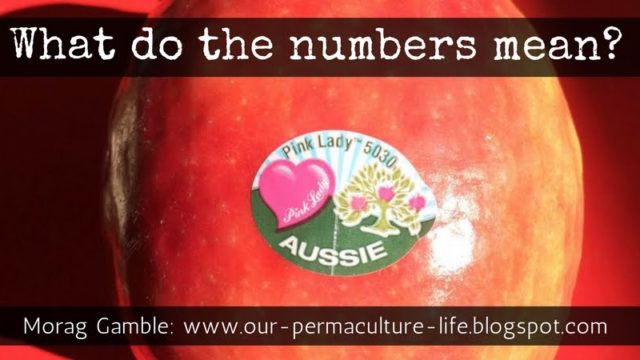Little sticky fruit labels – you see them everywhere – on tables, floors, at the beach, stuck to the side of bins, in the compost … It’s not a major source of waste I know, but they are insidious.
In our house we are taking a critical look at the ways single plastic has crept into our lives. Our family has signed up to Plastic Free July and inspired to see how we can make positive lasting changes to reduce our plastic waste even further. It’s a great idea.
Have you signed up for the challenge yet? You can sign up for a day, a week, the month or longer. Plastic is just everywhere, but finding any ways we can reduce single-use plastic in our lives has to be a good thing.
Anyway, this morning my son was wondering about those fruit stickers. He was asking what they meant, what they were made of and why we needed them. Really good questions! He was amazed at what they could tell you and suggested I share this information in case anyone else wanted to know too. I hope you find this useful.
What are those numbers on fruit stickers?
The numbers on stickers are called PLU numbers which means Price Look-Up numbers. One of their keys uses is to help the person at the check-out know what fruit you have and charge you the right amount.
They are internationally used – the code for conventionally-grown yellow bananas (4011) is the same everywhere in the world, just as 3424 is the number for purple or red carrots.
There are around 1450 PLU numbers issued and they each refer to a different type of fresh produce. You can look them up on the PLU code database http://www.ifpsglobal.com/Identification/PLU-Codes/PLU-codes-Search.
The number doesn’t tell you where they are from, who grew them, although sometimes this information is also on the label.
How do I tell from the fruit sticker if it is really organic?
- Four digit numbers are conventionally grown (eg: 4011 – conventionally grown yellow banana)
- Five digit numbers starting with ‘9’ are organic. (eg: 94011 – organically grown yellow banana)
- Five digit numbers starting with ‘8’ are genetically modified. (eg: 84011 – GMO grown yellow banana) – very rarely seen or used.
- Five digit numbers starting with ‘3’ (#3xxxx) mean that the produce has been electronically pasteurised (irradiated).
Can I tell from the fruit sticker if my fruit is genetically modified?
Just because there is a category for genetically modified produce, most suppliers would not label it as such.
Having said that, no fresh produce grown in Australia can be GMO and no fresh produce containing GMOs from other countries can be sold at this point either.
Different countries have different standards so it is good to check the situation in your region. However, from the labels, the only way to be sure that your shop bought produce is not genetically modified is by purchasing organic products (a five digit number starting with a ‘9’). Organics do not allow GMOs.
I found this really interesting overview of which foods might contain GMOs
This document it says that in the USA, there are GMO apples, papaya, potatoes, pineapples, sweet corn, yellow crookneck squash and zucchini available.
Australia has approved the use of GMO potatoes in chips – so you may well be getting GMO spuds when you buy frozen chips, or go to the local chippy, and they could be cooked in GMO canola oil too. Another reason to buy fresh ingredients and cook from scratch.
How do I avoid these fruit stickers?
In most of the bigger supermarkets and conventional food stores you will find these stickers on almost individual pieces of fruit. However you can avoid them when you shop at an farmers markets, organic food stores, community supported agriculture programs or, of course by growing your own fruit.
 |
| Home-grown label-free produce. |
Are the stickers edible?
I came across a lot of sites saying that these little stickers were made of edible paper with food grade glue so if you accidentally swallowed one it wouldn’t really matter.
I’m not convinced. Maybe they are in some places, but not here, or not consistently. I found an apple with a sticker and did a little test. It was super stretchy. Last time I checked, paper didn’t have these qualities.
Best avoided!




Thanks for the info Morag, I always did wonder what the numbers meant. Have a lovely day.
Fi
Thank you Morag and Hugh a very interesting article – I printed out the coloured chart until I remember what's what. I can remember the day when there weren't any sticky labels on fruits…..now that dates me doesn't it?
Australia is far away from most places so this should be the "go to" place for everything that is green and clean and much sought after (it doesn't make sense to spoil everything). Once GMO has it's claws into us there's no going back.
That was great info. Please thank your son for asking such great questions and suggesting you share. Ill be sharing this info with my children also.
I've asked the family not to put these stickers in the compost as many of they don't breakdown. Ruth
Thank you for this Morag. I must admit that I have never looked at what was on those stickers. Shame on me!
Thank goodness I only buy a few items from the supermarkets now that I am growing my own.
I must remember number 9 when I go shopping next. Its my lucky number, so shouldn't be too hard 🙂
xTania
They're definitely not made of paper. I used to think they were until I found hoards of them in my compost after months of decomposition. I make sure to dispose of them in the bin before putting them in the compost. Then again, as you said, they're not a big issue in terms of volume.